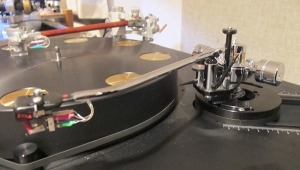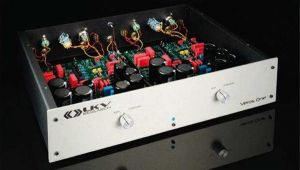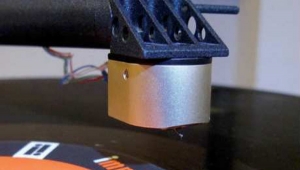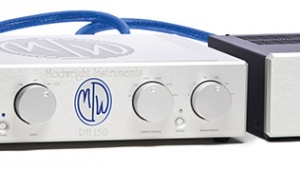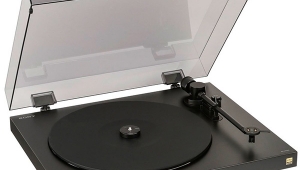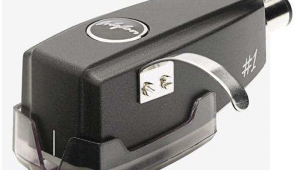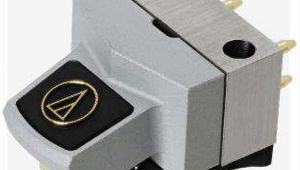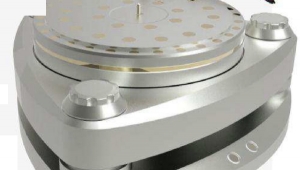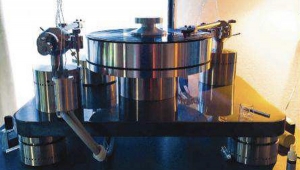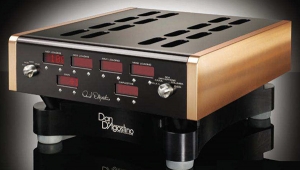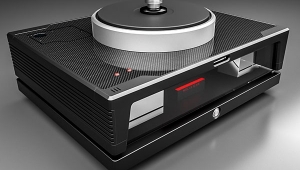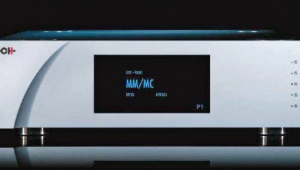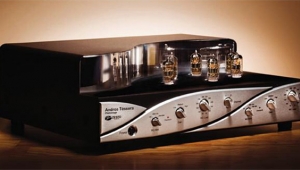| Columns Retired Columns & Blogs |
Analog Corner #255: Kuzma Stabi M turntable, Audio Tekne TEA-8695 and Xactive Argo phono preamplifiers
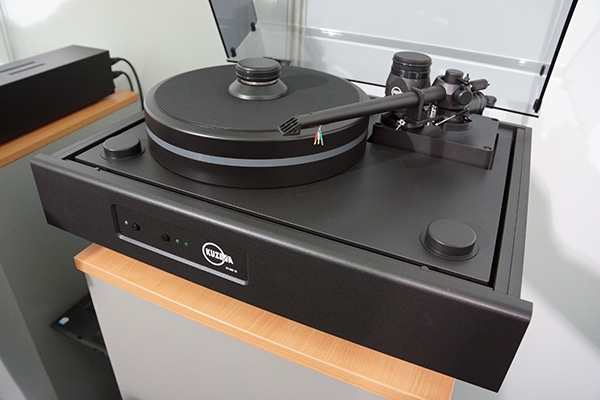
Do good things come in small packages, or is bigger better? Your call. But regarding the products they've sent my way for review this month, designers Franc Kuzma, Kiyoaki Imai, and Velissarios Georgiadis are all in the latter camp. Kuzma's Stabi M, designed to accommodate the 14" version of his 4Point tonearm, is a massive turntable with a big footprint. Imai's Audio Tekne TEA-8695 tubed phono preamplifier has 11 Permalloy core transformers and weighs nearly 100lb. And although it uses just four signal-path tubes and a pair of rectifier tubes, Georgiadis's Xactive Argo phono preamplifier fills the full width, height, and depth of a Harmonic Resolution System shelf—and not because it's a big but mostly empty housing.
Footnote 1: Kuzma Ltd., Hotemaze 17/a, SI-4205 Preddvor, Slovenia. Tel: (386) 4-253-54-50. Fax: (386) 4-253-54-54. Web: www.kuzma.si. US distributor: Elite Audio Video Distribution (Scot Markwell), PO Box 93896, Los Angeles, CA 90093-0896. Tel: (323) 466-9694 x22. Fax: (323) 466-9825. Web: www.eliteavdist.com
Kuzma Stabi M turntable and 4Point 14 inch tonearm
Deeper into Darkness: I'm very familiar with Franc Kuzma's expertise in design and machining (footnote 1). I've reviewed his diminutive, pipe-bomb-like, lower-end Stabi S turntable, with Stogi S unipivot tonearm; his top-of-the-line Stabi XL, with high mass, a minimal footprint, two motors, and Air Line air-bearing tonearm; and his unique 4Point tonearm, which I bought and continue to happily use. I'm a fan.
Unlike Kuzma's earlier, minimal-plinth turntables, the Stabi M has an old-fashioned, maximum-plinth design with a solid-aluminum outer frame measuring 23.6" wide by 11" high by 19.7" deep. The look, in solid black, is oversize and imposing. Included is a large, spring-hinged, thick-acrylic dustcover whose vibration-resistant design made it among the most difficult to engineer of the Stabi M's features, according to Kuzma. (It was too large to use in my system.)
A massive, elastically isolated inner platform sits within the Stabi M's outer frame. This contains the large DC motor and an inverted platter bearing, 16mm in diameter, topped with a ruby ball. Rotating on the ruby bearing is the aluminum subplatter, driven by a stiff plastic belt. The motor is suspended from the inner platform within a massive brass housing attached to an aluminum plate, to provide isolation from both the inner platform and outer frame, with sufficient rigidity to allow high-torque drive. Kuzma claims that this combines the "positive properties of both belt and idler drives, while minimizing the negatives [of] each."
A conical, machined cutout on the underside of the 26.5lb platter securely accepts the subplatter's tapered hub. The platter comprises two 40mm-thick aluminum discs sandwiching an acrylic damping plate.
An external power supply, connected via a pair of multi-conductor cables, drives the DC motor via a precise frequency; very fine adjustments of speed can be made and monitored on the supply's front-panel display. Start/Stop and speed-change buttons (33 1/3 or 45rpm) are provided on the outer frame's front panel.
The Stabi M is designed so that its platter reaches full speed within two seconds, or one full rotation of the platter. All of this mass, metal, and acrylic total 132lb, for $19,225 without tonearm—in my opinion, a more than reasonable sum for what's available at or near this price.
Although the Stabi M can accommodate just one tonearm, the ease with which you can swap out and adjust the 4Point arm's headshells makes this a nonissue. You can also swap armboards by removing just a few large bolts. The Stabi M's is one of the thickest, most massive aluminum armboards I've ever seen. A screw-on record clamp and a battery-powered handset for remotely starting and stopping the platter—the latter function might be useful if you find yourself in a music- (or drug- or alcohol-) induced stupor—are also included.
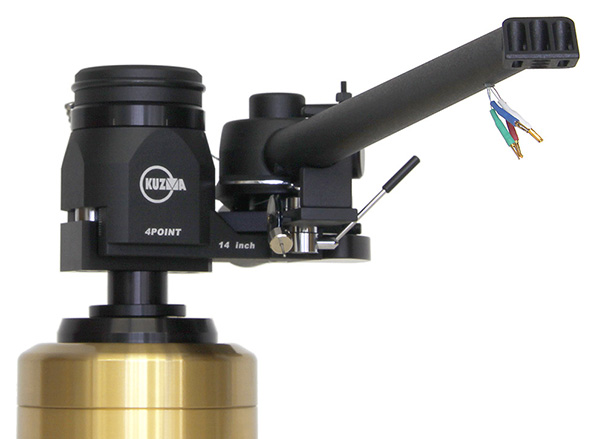
Kuzma 4Point 14 inch tonearm: I reviewed the 4Point in the September 2011 issue; please read the review for full design details and a description of the arm's sound. To briefly recap: Instead of using a traditional gimbaled or unipivot bearing, the 4Point pivots on four hardened points sitting within cups: the two points for vertical movement are more easily seen; the pair for horizontal movement sit inside a large-diameter vertical shaft.
This design can be thought of as comprising four unipivot bearings that combine the benefits of unipivots with the rigidity and stability of gimbaled bearings. Skeptics would say that having four unipivots is four times less effective than using a single point that's fully pressurized by the arm's entire mass. Fight among yourselves!
The standard 4Point costs ca $6500 and up, depending on wiring choice. My 4Point has an effective length (ie, pivot-to-spindle length plus overhang) of 11" (279mm). While the pivot-to-spindle distance is a long 10.39" (264mm), the arm's offset pivot design means that the mounting distance—the distance from the platter spindle to the center of the arm's VTA tower—is just 8.346" (212mm). This is similar to the mounting distance of a 9" or 10" arm, and it's why my Continuum Audio Labs Caliburn—a turntable designed for arms with an effective length of 9.409" (239mm)—was able to accommodate my 4Point.
Despite the 4Point 14 inch's effective length of 353mm (13.9"), the mounting distance of 11.5" (292mm) is closer to that of a typical 12" arm, which the Stabi M can also accommodate while playing records with the dustcover down. The 4Point 14 inch costs from $8995 to $10,270, depending on wiring choices.
Is longer better? Assuming that any tonearm designer's—not just Franc Kuzma's—mathematical calculations are correct, the advantages of longer armtubes are lower lateral tracking error (LTE), as well as less skating, due to a smaller offset angle for the headshell. Disadvantages include a possible lessening of the arm's stiffness, greater mass, and more cumbersome performance in the groove due to a greater moment of inertia—and the fact that any error in setup will be magnified. Every supposed improvement comes at a cost. Off the record, some tonearm designers will tell you that, all else being equal, they prefer 9" or, at most, 10" arms, and that they make longer arms only to meet market demand.
My experience with both the Continuum Audio Labs Cobra (9.5" effective length) and Swedish Analog Technologies (somewhat less than 9.5" effective length) arms is that the LTE of a properly set-up pivoted arm produces less distortion than the rest of one's audio system, which makes LTE, essentially, a nonissue. You should not hear LTE from a properly set-up 9" arm, and I don't—nor do people who enjoy my rips at audio shows. More often than not, they don't even know they're listening to vinyl.
If you think otherwise, knock yourself out with long arms on large-footprint turntables like the Stabi M's, or those of SME's 12-series. In fact, for $5310, you can upgrade your standard 4Point with a 14" wand. I'm just here to express my opinion based on my own experience, not to tell you what to think or like or own.
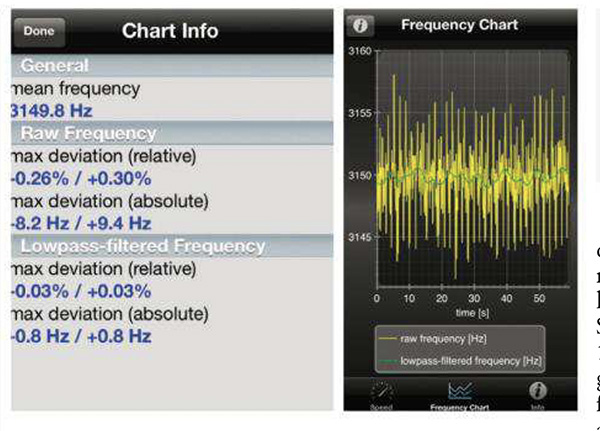
Fig.1 Kuzma Stabi M, speed stability data (left). Fig.2 Kuzma Stabi M, speed stability (right; raw frequency yellow; low-pass filtered frequency green).
After checking and adjusting its speed and letting the Stabi M spin for a few days, I used Dr. Feickert Analogue's PlatterSpeed app to assess speed accuracy. Figs.1 and 2 show very good, if not exceptionally good, speed consistency. I cleaned the belt, measured again, and got the same results.
Sound—Stabi M plus Kuzma 4Point 14 inch: Together, the Stabi M and 4Point 14 inch cost $28,220 and up. The sound of them together was so highly accomplished and tonally well balanced that at first I found it hard to describe, other than to note its striking foundational solidity. The combo produced rock-solid images, impressively stable soundstages, and an iron-willed sense of musical grip. Backgrounds were quiet, and the rejection of impulses such as pops and clicks was very good. Still, when I tapped a finger on the Stabi M's sturdy frame or on the Harmonic Resolution Systems base beneath it, the 'table passed the taps along to the speakers with surprising liveliness.
The Stabi M's freedom from obvious tonal colorations was very good, bass control and extension were exceptionally good, and macrodynamics were very, very good. Want slam? You got it!
However, compared to either of my far more expensive reference turntables and tonearms, as well as to another more expensive 'table-arm combo currently under review, the Stabi M and 4Point 14 sounded definitely drier in the midrange, and exhibited less bloom and ease of musical expression. In other words, the Kuzma combo somewhat suppressed sustains, while also pleasantly emphasizing image "structure" and soundstage focus. Adjusting the arm's horizontal and vertical damping troughs didn't change that observation.
The Stabi M and 4Point 14 inch combo also produced sonic tapestries that weren't quite as fine or delicate as those woven by the more expensive rigs. All of these observations are based on putting a Lyra Atlas cartridge in all three arms, on all three 'tables, and were confirmed by recording the same tracks at 24-bit/96kHz. This drier, less bloomy quality is probably what made more obvious the Kuzma combo's ability to produce those "rock solid images, impressively stable soundstages, and an iron-willed sense of musical grip." Were the Stabi M my turntable, in order to get a better balance in my system I'd go with a bloomier cartridge than the Atlas—say, a Kiseki Purple Heart or a Koetsu.
More important, those other 'tables were equipped with tonearms of 9.5" effective length. In terms of audible distortion and/or tracking artifacts, I couldn't tell the 9.5" arms from the 4Point 14 inch, no matter where on the record surface I dropped the needle. (I made recordings that demonstrate this as well.)
Hence my conclusion: If you must have a really long tonearm, the Stabi M and 4Point 14 inch make a great combination for a very reasonable price for the sound quality it offers, and for its superb design and build quality—especially if you like rock, for which its low-end grip, extension, and slam were superb.
But I didn't hear any sonic benefits from that 14"-long arm, so I don't think it's really necessary—and so neither is the large platform required to accommodate it. Still, if you like how it sounds and what it looks like, and are convinced that longer is better, don't let me stop you. This is a 'table built to last several lifetimes.
The standard-length Kuzma 4Point remains one of my favorite tonearms, regardless of price. In fact, I wish Franc Kuzma had made a shorter 4Point—a 9.5" model. But that's just me.
Footnote 1: Kuzma Ltd., Hotemaze 17/a, SI-4205 Preddvor, Slovenia. Tel: (386) 4-253-54-50. Fax: (386) 4-253-54-54. Web: www.kuzma.si. US distributor: Elite Audio Video Distribution (Scot Markwell), PO Box 93896, Los Angeles, CA 90093-0896. Tel: (323) 466-9694 x22. Fax: (323) 466-9825. Web: www.eliteavdist.com
- Log in or register to post comments

